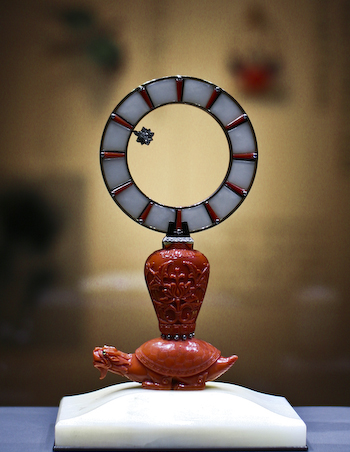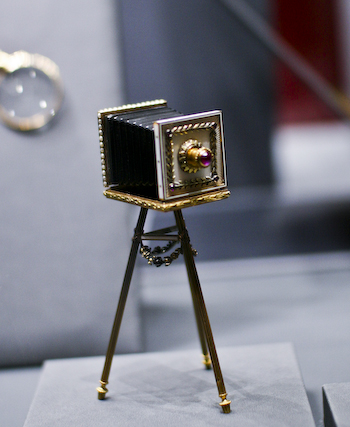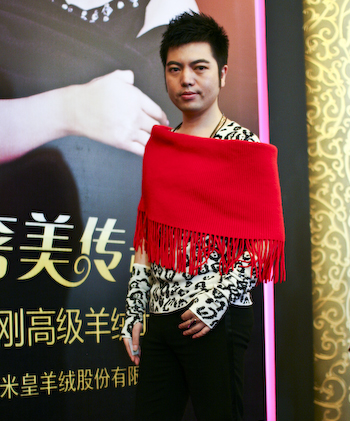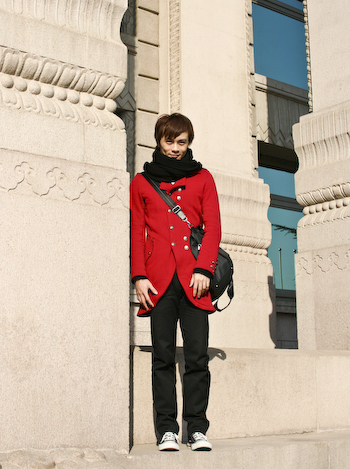I have high-resolution photos from all the shows. If you ask me nicely and tell me the ones you want, I might send you some.
Tag: China Fashion News and Analysis ä¸å›½æ—¶è£…æ–°é—»åŠè¡Œä¸šåˆ†æž
News about China’s fashion market and industry, including reports on factory visits, events, etc.
Cartier Collection at the Forbidden City

Catch this show (more at the Telegraph) in the Meridian Gate (åˆé—¨ï¼‰as soon as possible. It ends with November. The Chinese-influenced pieces, mainly from the 1920s, are beautiful and surprising. The rigor with which Cartier artisans studied and imitated the motifs and techniques of traditional Chinese jewelry is impressive. The object above joins a Chinese-style tortoise with Western horological genius.

This was one of my other favorite things. It is a tiny picture frame in the shape of a camera. It is about four inches tall.
Me on China Fashion Week at 163.com
Here I am, unedited, and sounding like an intellectual who doesn’t know very much. I was caught on my way out of a show and did not have any time to prepare. There wasn’t really even that much cat.
Also, at stylelist.com, here are pictures of the 20 strangest looks from China fashion week, without any mention of the designers. I know the names of some of them though there are sadly quite a few that I did not catch.
China Fashion Week Awards Ceremony: Li Xiaoyan Gets Gold!
Last night, Ms. Li Xiaoyan (æŽå°ç‡•) received the 2009 (for SS ’10 collections) gold prize for the best collection. This award is presented by the organizations that organized this, the thirteenth China Fashion Week. Learn more (in Chinese) on Yoka and Sina. View the award winning collection here at Yoka.
I met Ms. Li, originally from Taipei, after her show and she was nice enough to present me with the scarf she was then wearing, which is also part of the award-winning collection. This nice souvenir made up for the fact that my press ID was confiscated later that night because it was actually registered in my subordinates’ name.
Guo Pei (scroll down) received the award for the best woman’s collection and Cabeen got it for men.
Enovate: Capturing the 500 Million
Enovate is very relevant. The site charts the behaviors, ideas, and patterns of the world’s most important rising consumer group. Subjects from Erguotou to Wuliangye, and from anti-innovation to social entrepreneurship make comprehensive Enovate a daily must-see for those seeking to penetrate the dazzling China youth market.
Beauty Berry
This menswear show was the best I have seen at China Fashion Week SS ’10. I particularly liked the patent leather shoes.
Yoka.com: Source for China Fashion Week Pics
Here are pics of full collections ala style.com from Yoka:
Secfashion by Qi Gang (ç¥åˆš)
Tsai Meiyue (蔡美月) Wedding Dress Collection
Mihuang (米皇) Cashmere Collection by Qi Gang (ç¥åˆš)
Also, here’s a nice China Fashion Week gallery by the Reuters photographer, Grace Liang, at Canada.com. Too bad I missed the Mao Geping Show.
Pics from Qi Gang at Yoka.com
Yuan Yuan (元元)the fashion editor for Yoka.com, has been at every single China Fashion Week event with a photographer. The 80 looks from the Qi Gang (ç¥åˆšï¼‰show are all there. Some highlights are these arm baubles (what’s the proper term?), this rather nationalistic cape, this women with a walking stick, this member of the Congolese royal family from 2225, and this dress, of which I thought each member of the audience deserved a piece.
My overall reaction is that I just didn’t realize Sioux warriors were marrying into the Coruscant aristocracy.
China Fashion Week, Tuesday Roundup
Some shows have been memorable, some bland, and others had nice pieces. As one might expect, there is quite a difference in the types of people who attend each show, based largely on the clout of the brand and the designer. Some are filled with design students and some boast the gliteratti of the fashion press. Here is the China Daily introduction to the week.
I skipped the NE Tiger (东北虎)show on Monday because I had to write an article and their shop displays have always irritated me. The designs seem like an injustice to the majestic beast. Still, the pics make look interesting in a way.

Qi Gang (above) is one of the names I hear most this week (his two shows are Mihuang (米皇) Cashmere Collection and Secfashion). Apparently, the vast majority of the items in the Mihuang show were 100% cashmere or blends.
The second show I saw was Entra, which seemed more wearable and less conceptual.
Next was the Tsai Meiyue wedding dress show. It opened with a very cute little girl (scroll down) coming down the runway with one of the models. The show was pleasant. Focusing on wedding dresses is a clear recipe for success here.
The Throb Immobile show was traumatizing, as the name of the brand could imply. The clothes, models, and music all seemed to suggest the lifestyles of the elite in some dystopian future in which natural fibers have gone the way of the polar ice cap. The show ended with a yet another, still more mangled, electro Carmina Burana, which will prevent me from ever again enjoying Orff’s masterpiece.
The styles at the DGVI show ranged from sexy, to tawdry, to gaudily slutty, meaning it was quite entertaining and fun. There was an actual DG and some of the music played was very charming. The style was Miss Sixty with a strong dose of Wenzhou, which is probably where most of the dreadfully cheap chic of that Italian brand is produced anyway. The problem with fashion shows like this, especially in China, is that I’m never sure about whether the effect of the clothes and styling is what was intended by the creative team. Well, actually, in this case I think it was. Mr. Li Zhilong, the heavily-accented Creative Director, wearing a shiny (clearly synthetic) velvet suit and shades, looked right in his element surrounded by the models, all in jeans that had at least ten zippers. This was the only show I’ve seen that had a large number of foreigners in the audience. I think the entire German and Austrian embassies were there. Afterwords, this show also had a nice cocktail party, as foreigners tend to expect.
The high point of Tuesday was the Cocoon show. This view is clearly shared by the fashion media as this was the only event on Tuesday at which the elites of that group were in evidence. Both the China Vogue and Bazaar editors-in-chief attended as did some minor Hong Kong celebrities. This show had quite a bit that stylish women would really covet. It was also the first one that revealed some understanding of color. The use of polka dots was especially appealing. The night shows are the must-see ones.
Han Han (韩寒)
This Time article on blogger and author Han Han (韩寒) might be interesting for those attempting to understand the youth appearing on Stylites.
After Mihuang Show, China Fashion Week 2009

Held at the Beijing Hotel and D-Park at 798, the second 2009 China Fashion Week celebrates the designs of brands based all around China, but with something of a focus in Guangdong and Zhejiang. I will have quite a more on this later, but for now here is Terry, a stylist at Tony Studio, after the “Mihuang” Qi Gang Cashmere High Class Fashion Show.
Ten Facts on Youth in China
This piece from Mobile Youth provides some valuable pointers to those seeking to market to this group whose fashions I so assiduously document.
ChinaLuxCultureBiz
This blog is a should-see for people interested in the China luxury goods industry.
Chinese Parvenus Still Seek Status
And LV and Gucci still represent it.
This article on the condition of the China luxury market at Luxury Society quotes me about midway down. The main thesis is that Chinese continue to love buying luxury goods – the rate of growth in their consumption is the big bright spot for the industry – but they prefer to spend in Hong Kong and abroad due to lower taxes and wider selection. Those who can afford luxury goods can also buy a plane ticket and are eager to do so since foreign travel may be an even bigger status symbol than a braided Bottega Veneta. The main reason to invest in a shop here is to educate Chinese consumers so the brands are already by the time they arrive in Tokyo or Paris.
Th Financial Post (Canadian) echoes the theme that China’s luxury goods market is still buoyant. The article cites a study by New York’s Pao Principle that claims China’s elites buy Prada and Cartier to set themselves apart from their peers. Perhaps they should have said that the new rich buy luxury to differentiate themselves from the peasants and signal that they are members of an elite group. They seek to show that they are keeping up with their peers by buying the same stuff. Those appearing on Stylites want to show, through consumption choices and other methods, that they are not part of the crowd.
The Gap to Enter China
The first shop of the largest American fashion retailer will open here next year, according to the LA Times. There’s much discussion there about where the Gap will fit into the retail landscape. The arrival of the Uniqlos, H&Ms, Zaras, C&As, and other foreign mass fashions is one of the big stories of the last years. Fast fashion took a lot longer to arrive than luxury brands – the middle class has exploded only after a wealthy class had already emerged.
How will Gap, with its more conservative designs, and likely higher prices compete for young buyers who tend to be more fashion forward than their US counterparts? Perhaps it will instead target an older group group of buyers, who might also have the physique to wear Gap’s more generous fits. The market actually does lack the higher quality (compared to Zara) basics offered by Gap and Banana Republic. Good, but affordable, simple office and casual clothes in natural fibers might be the main appeal of Gap or Banana Republic.
I’m not a big fan of Gap or Old Navy. Banana Republic has a few more items that I like, but it also doesn’t offer much that is distinctive. One can’t expect such large chains to have personality. Still, I would say that J. Crew has a bit more style. Anyway, all of them produce most of their items right here in big bad China.